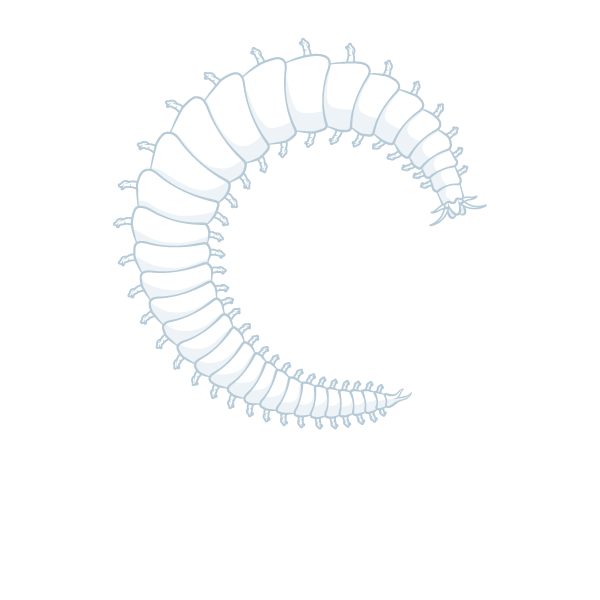Sustainable protein sources
Worms – an emerging source of proteins
Everything that lives – from the smallest microorganism to the giant whale – has something in common; the need for nutrition – enough nutrition to grow and to reproduce. The question many now ask themselves is: where do we find enough food to satisfy the population of the future? A population which in 2055 will likely have exceeded 10 billion people. Every single one will need to eat, and an important ingredient in the global cycle of nutrition is proteins.
So where do we find them?
With the human being well placed on top of the food pyramid, and a fast growing population, it’s about time we find out where we can obtain enough proteins to avoid a global dilemma. Today, an estimated 2 billion people suffer from malnutrition due to lack of micronutrients. And in emerging economies, the demand for animal protein is growing explosively, partly due to rising incomes and urbanisation.
Limited oceans
The sea has long been designated as an increasingly important resource for food, but even in the vast oceans the resources begin to limit themselves. Large parts of the fish currently caught in the world’s oceans are used in fish farming.
Back in 2011 more than 90 percent of our global fish stocks were overexploited. This kind of overfishing takes an enormous toll on marine ecosystems, and so the world is relying more and more on farmed seafood.

They started with research
– High quality proteins will be hard to come by in the years to come, says OddGeir Oddsen, the CEO of Sea Farms Nutrition, a company located United Kingdom. Established in 2013 by a group of researchers and business people, the company supplies specialized feed to a variety of species produced in aquaculture plants. Much of this goes to Asia and Central America. Sea Farms Nutrition has also developed its own hatchery feed, and the demand for such specialty foods is increasing.
– The enterprise actually began as a research project between several participants from different stakeholders as feed supplier, worm farmer, aquaculture specialist and seafood suppliers, Oddsen explains. Our shared vision is no less than to provide a new solution. Today our goal is to create innovative feed formulations for aquaculture production, without the dependency on fish ingredients.
– We have to get proteins from somewhere, says Oddsen. – Trying to feed the world using land-based animal proteins will have dire consequences. In addition to deforestation, greenhouse gas emissions and waste, industrial animal farming on a large scale leads to soil degradation on an unsustainable scale. Therefore a large part of our food supply needs to come from aquaculture.
Worms – an emerging source of proteins
Sea Farms Nutrition has focused on farmed polychaetes, also known as bristle worms. Farmed polychaetes are an effective way of producing edible proteins that can form a foundation for high quality aquaculture feed. Oddsen and his partners hope that they can provide an exceptional effective feed, and help the aquaculture industry to bring better food to consumers.
– We need to start thinking about consuming and producing proteins sustainably, is Oddsen’s clear message. The development of sustainable animal feed, both on land and under water, represents a giant leap in the right direction. One of the key elements in this area is the conversion of different waste materials into proteins. A very efficient way of doing this is by using worms; more specifically polychaetes. Polychaetes contain nutritious, versatile proteins that can form a solid foundation for high quality aquaculture feed.
From waste to value
Polychaetes convert a wide range of nutrients into protein, which again allows the company to convert nutrient sources that would normally be considered waste, into valuable protein sources. But they are not satisfied just with turning polychaetes into a high quality aquaculture feed. They are determined to use polychaetes to quite simply create the best and most effective aquaculture feed in the world. Oddsen and his colleagues in Sea Farms Nutrition are currently working on research that will increase the production of worms.
From bio-secure ponds
– We get our farmed polychaetes from bio-secure ponds in The Netherland, sais Oddsen. – Our idea with Sea Farms Nutrition was – and still is – quite simple: Feeds made from polychaetes is an environment-friendly and effective alternative. The future of aquaculture needs to be sustainable. And sustainable aquaculture needs to rely on environment-friendly feed.
Great nutritional benefits
Oddsen claims there are a number of advantages to using farmed polychaetes as feed in aquaculture. Perhaps the most important is that farmed polychaetes have as good nutritional value as traditional feed from fish. In addition they also contain important amino acids, peptids and other functional molecules that are not found in the same amount in traditional fish feed.
More growth
This feed is more protein-efficient and allows species such as shrimp to grow faster and healthier, giving less emissions to the environment. Tests done with rainbow trout show that after 12 weeks, the weight gain is 14 per cent higher with added farmed polychaetes in the feed than without it. In addition worms and feed has been tested for parasites, bacteria and viruses. This ensures a disease-free feed.
Better tasting food
The taste of seafood is also important. According to a professional taste panel species fed with farmed polychaetes also taste fresher and better. Last but not least, the use of farmed polychaetes makes the entire value chain of a modern aquaculture more sustainable.
If you’re interested in testing our innovative protein in your feed, please don’t hesitate to get in touch. We look forward to assisting you in improving your feed.

